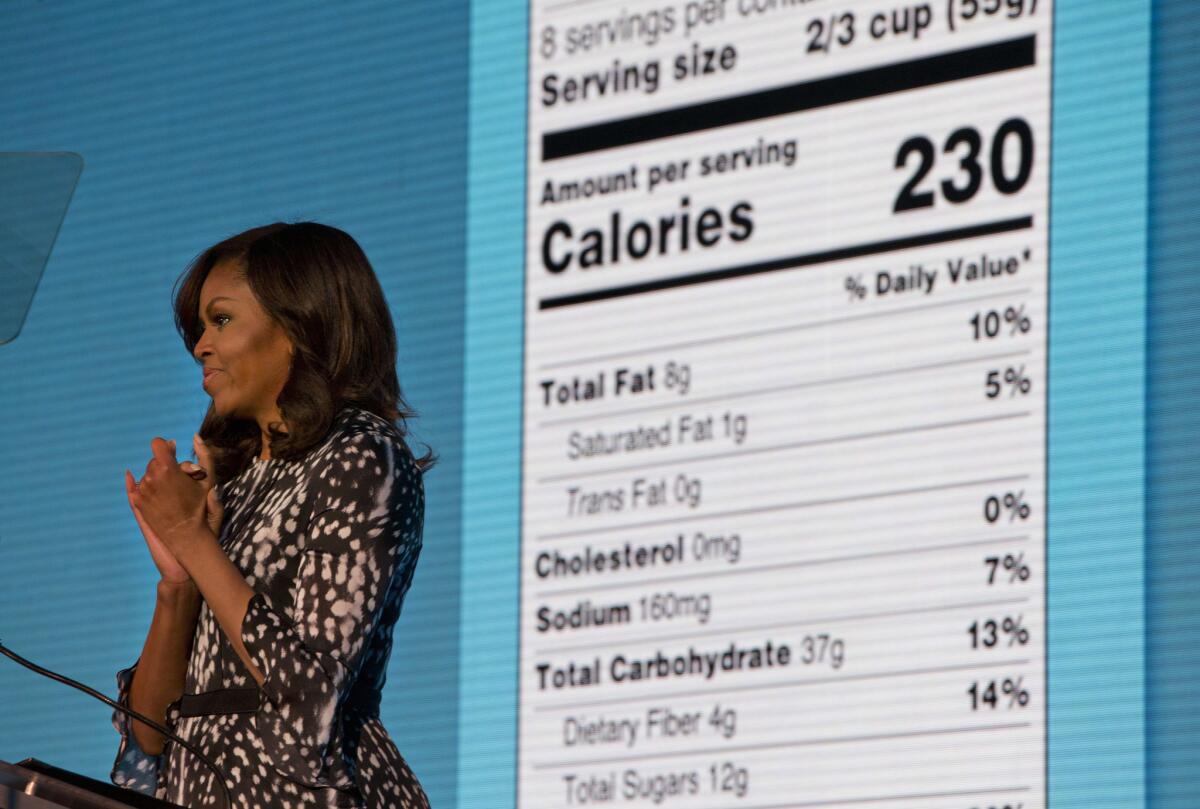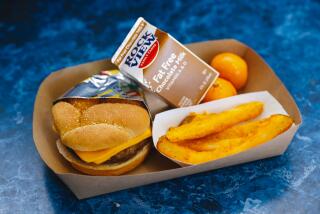Makeover coming for food nutrition labels

- Share via
Nutrition facts labels on food packages are getting a long-awaited makeover, with calories listed in bigger, bolder type and a new line for added sugars.
And serving sizes will be updated to make them more realistic — so that a small bag of chips won’t count as two or three servings, for example.
“You’ll no longer need a microscope to figure out whether the food is actually good for your kids,” First Lady Michelle Obama said Friday. She was announcing final rules for the new labels in a speech at an annual health summit as part of her “Let’s Move!” campaign against childhood obesity.
The changes were proposed by the Food and Drug Administration two years ago and are the first major update to the labels since their creation in 1994. They are now found on more than 800,000 foods.
The calorie count is in bigger font, so you can actually see it. This label will tell you how much of the sugar in your snack was added after processing.
— Michelle Obama
“The calorie count is in bigger font, so you can actually see it,” the first lady said. “This label will tell you how much of the sugar in your snack was added after processing.”
The overhaul comes as science has changed in recent decades. Though fat was the focus in the 1990s when the labels were created, these days there is more concern about how many calories people eat. The calorie listing will now be much larger than the rest of the type on the label, making it hard to overlook.
Serving sizes will also be easier to see, listed at the top of the graphic. And it will be easier to discern how many servings are in a container as part of an attempt to revise often misleading serving sizes.
See the most-read stories this hour >>
Calculations for serving sizes will also be revised. The idea behind listing a whole package of food, or a whole drink, as one serving size isn’t that people should eat more; it’s that they should understand how many calories are in what they are actually consuming. The FDA says that by law, serving sizes must be based on actual consumption, not ideal consumption.
Nutrition advocates have long asked for the added sugars line on the label because it’s impossible for consumers to know how much sugar in an item is naturally occurring, like that in fruit and dairy products, and how much is added by the manufacturer. Think an apple versus apple sauce, which comes in sweetened and unsweetened varieties.
The labels will also include a new “percent daily value” for sugars, meaning the percentage of a person’s recommended daily intake of added sugars in that particular food item. New dietary guidelines announced this year recommend that people get no more than 10% of calories daily from added sugars. Since the calculations are based on an average diet of 2,000 calories, that means people should get no more than 200 calories of added sugars a day.
Michael Jacobson, president of the advocacy group Center for Science in the Public Interest, says it’s currently impossible for consumers who look at the labels to know how much sugar in foods is added and how much fits into a reasonable diet.
“Besides helping consumers make more informed choices, the new labels should also spur food manufacturers to add less sugar to their products,” Jacobson said.
Other changes to the labels: They must now list levels of potassium and vitamin D, two nutrients Americans don’t get enough of. Vitamin C and vitamin A listings are no longer required but can be included. Iron and calcium will stay.
The food industry has two years to comply.
Reaction to the labels from food companies has been mixed since they were first proposed. While some companies have fought the new line for added sugar, others have supported it. The Grocery Manufacturers Assn., which represents the food industry’s largest companies, has supported the larger print for calories.
“This update is timely as diets, eating patterns and consumer preferences have changed dramatically since the Nutrition Facts panel was first introduced,” said GMA’s Leon Bruner.
ALSO
Americans could prevent roughly half of all cancer deaths by doing these four things
California adds 59,600 jobs in April, unemployment ticks down to 5.3%
The tipping point: Why restaurant patrons don’t want to stop leaving gratuities
More to Read
Inside the business of entertainment
The Wide Shot brings you news, analysis and insights on everything from streaming wars to production — and what it all means for the future.
You may occasionally receive promotional content from the Los Angeles Times.










